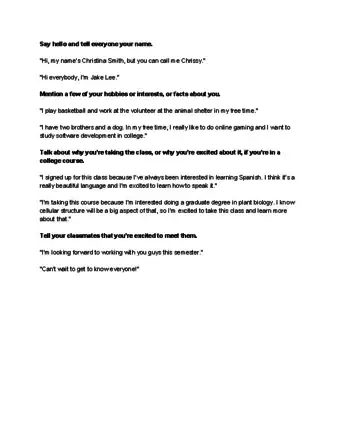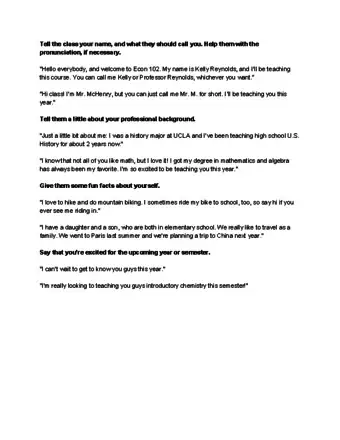This article was co-authored by Ashley Pritchard, MA. Ashley Pritchard is an Academic and School Counselor at Delaware Valley Regional High School in Frenchtown, New Jersey. Ashley has over 3 years of high school, college, and career counseling experience. She has an MA in School Counseling with a specialization in Mental Health from Caldwell University and is certified as an Independent Education Consultant through the University of California, Irvine.
wikiHow marks an article as reader-approved once it receives enough positive feedback. In this case, 81% of readers who voted found the article helpful, earning it our reader-approved status.
This article has been viewed 1,149,931 times.
Introducing yourself to a class, whether you are the student or the teacher, can feel daunting. Deciding what and how much to share, overcoming anxiety, and presenting yourself as an interesting and engaged person are steps that will help you introduce yourself with confidence, both in a physical classroom or in an online setting.
Steps
Giving Your Introduction Speech
-
1Stand up when it’s your turn to introduce yourself. This will make you appear more confident and will help you speak more clearly than if you were to stay seated. It may feel awkward to stand up, but your introduction will be over more quickly than you think.[1]
- If you are sitting in the middle of the room, you may want to turn your head from side to side occasionally as you speak so you can address the entire class.
-
2Smile when you speak. Even if you are super nervous, smiling will make your voice sound calmer and will help you mask that nervousness. It also shows your classmates and your teacher that you are friendly and approachable. Also, smiling stimulates the production of endorphins, so you are helping yourself to feel a little happier, too![2]
- Scientific studies have shown that making yourself smile when publicly speaking endears others to you as they naturally will want to smile back.[3]
Advertisement -
3Speak with confidence. Chances are that even if your voice is shaky, others won’t notice that. You want everyone to be able to hear you, so when you introduce yourself, do so in a clear, loud voice. Don’t mumble or stare down at the ground. It’s perfectly okay to be nervous—lots of people are when speaking in front of others! But if you can take a steadying breath and project confidence, you’ll be through your introduction before you know it.[4]
- Try practicing your introduction in a mirror to prepare yourself beforehand.
- A lot of the people in your class will be thinking about what they are going to say when it’s their turn and may not even be watching you the entire time you’re speaking.
-
4Give your name first. It’s helpful to give your first name, pause, and then give your first and last name, like “Hello, my name is June, June Thompson.” The repetition makes it more likely that others will remember your name.[5]
- If you prefer to go by a nickname, this is the time to give that detail. Say something like, “Hi, my name is Marcella, Marcella Smith, but you can call me ‘Marcie.’”
- Include your pronouns in this part of the speech. For example, you can say something like, "Hello, my name is Sydney, Sydney Caldwell. I use she/her pronouns."
-
5Share why you are taking the class. If you’re in a college course, you can share your intended major. Or if you’re taking a class for a certification for a job, you could share what it is you do for work. For example, you could say, “Hi, I’m Mark, Mark Palmer. I’m an Economics major, and this class is helping me get a certification I need to graduate.”[6]
- If you are only in the class because you have to be (like a general education course that all students are required to take), you don’t need to say that—chances are a lot of other people are in the same boat.
-
6Offer personable details, like hobbies or interests you have. If you are involved in sports or have pets or like to travel, the end of your introduction is a good place to give this information. You could say something like, “When I’m not studying, I like to train for and run in half-marathons.” This gives your classmates and teacher a memorable activity to tie to your name.[7]
- Avoid sharing overly personal details, like if you’re going through a divorce or recently lost your job. Try to keep things positive and upbeat—you don’t want your first impression to be negative or make other people uncomfortable.
EXPERT TIPAshley Pritchard is an Academic and School Counselor at Delaware Valley Regional High School in Frenchtown, New Jersey. Ashley has over 3 years of high school, college, and career counseling experience. She has an MA in School Counseling with a specialization in Mental Health from Caldwell University and is certified as an Independent Education Consultant through the University of California, Irvine.School Counselor
 Ashley Pritchard, MA
Ashley Pritchard, MA
School CounselorConsider including your pronouns in your speech. Your introduction speech is a good time to let your teacher and classmates know what your pronouns are. It's important that your pronouns are respected and that people address you appropriately.
Writing an Introduction for an Online Course
-
1Add a photo if you haven’t done so already. It’s always nice to be able to put a face to a name, and in an online course, the feeling of community has to form in a different way than in a traditional class. You can usually add a photo to your profile so it shows every time you post, or you could add an additional picture to your introduction post.[8]
- If you’re uncomfortable with adding a photo for privacy reasons, that is okay! If it was requested by your instructor, just send them an email about your reservations to let them know why you aren’t adhering to their guidelines.
-
2Keep your tone friendly and professional. Because you’re posting online, it can be tempting to slip into an informal way of “speaking” by using slang or loose grammar, so pay extra attention to your introduction post. Use full, complete sentences, proper grammar, and make sure to proofread before you hit “submit.”[9]
- Try reading what you wrote out loud to hear how it sounds—this may help you reword or restructure your introduction for the best flow.
-
3Share personal and professional information. Include information about why you’re in the class and about what you do during the rest of your time (either for work or for fun). For example, you could write “Hi, my name is Sharon Izzo, and I work during the day at a nursing home. When I’m not working or in class, I like to spend time with my spouse and our 3 rescue dogs.”[10]
- You can also share what city you live in if you’re comfortable with that—many students who are in online classes form study groups that either meet in person or online.
- Remember that less is more—your classmates will be less likely to read 5 paragraphs than they would 1 succinct paragraph.
-
4Respond to your classmates’ posts. This is the best way to start building rapport with everyone. Reach out to others who live in the same area or who share the same interests as you. Chances are if you’re in the same program, you might have multiple courses with them over the next 1 or 2 years.[11]
- Having an active presence in your online class will make your overall experience more gratifying, and it’ll also help you engage more with the material.
Introducing Yourself as a Teacher
-
1Greet students and introduce yourself once everyone is seated. Include your name (what you would like them to address you by), your academic background, and your interests. You could say something like, “Good morning class, my name is John Smith, you can call me John or Professor Smith. I received my degree in Communications from XYZ College and my masters from ABC University. I just moved to the area recently and enjoy exploring downtown and going hiking with my dog, Bruce.”
- It’s helpful to share details that students can identify with, but be wary of sharing overly personal information.
- This is also a time you could share any awards you have won, areas of study you are interested in or involved in, publications, or boards you serve on. You want to establish as much credibility as possible.
-
2Smile and address the entire room as you speak. Be welcoming and warm, making sure to look around the room as you introduce yourself. If you are nervous, try looking above the heads of the students instead of making direct eye contact. Move your body and walk around the room if you feel comfortable.[12]
- Remember that your students see you as the person of authority in the room. Chances are, they won’t notice if you are nervous or forget something you had planned to say. Be confident and know that there is always time to cover anything you may have forgotten.
-
3Pass out a syllabus/class instructions and answer questions. While you are giving your introduction, pass out the class syllabus so the students can begin looking it over. You can then refer to it after your personal introduction to share your expectations for the class (attendance, participation, structure, projects).
- Setting the tone for the class on the first day is an important part of teaching a successful, engaging course. Practice several times before you actually are in front of your students.
Community Q&A
-
QuestionHow do I make a joke when introducing myself in class?
 Community AnswerWhatever you want to joke about is your choice, depending on your humor! However, try to avoid political, religious, or any jokes that degrade you, your classmates, or your teacher. A good one might be, “Hi! My name’s (name), and I’m here to learn...and because my parents wanted me out of the house so they could have some peace and quiet for a change! But that said, I hope our school year goes well!”.
Community AnswerWhatever you want to joke about is your choice, depending on your humor! However, try to avoid political, religious, or any jokes that degrade you, your classmates, or your teacher. A good one might be, “Hi! My name’s (name), and I’m here to learn...and because my parents wanted me out of the house so they could have some peace and quiet for a change! But that said, I hope our school year goes well!”. -
QuestionHow do I overcome stage fright and improve my speaking skills?
 Community AnswerThe main thing is that you want to face your fear and fight it. Practice often. If you are not used to talking in front of a crowd or on stage, start small by talking in front of people you know. Practice is the key to improving your speaking skills as well. The more you take the opportunity to speak in front of people, the easier it will become.
Community AnswerThe main thing is that you want to face your fear and fight it. Practice often. If you are not used to talking in front of a crowd or on stage, start small by talking in front of people you know. Practice is the key to improving your speaking skills as well. The more you take the opportunity to speak in front of people, the easier it will become. -
QuestionHow do I introduce myself as a student in class?
 Community AnswerBe confident and start up the intro. Always smile and speak to the crowd. Don't have a gloomy look on your face, as this will make others think you're boring. Be active while you're speaking too, such as walking about a little and using hand gestures.
Community AnswerBe confident and start up the intro. Always smile and speak to the crowd. Don't have a gloomy look on your face, as this will make others think you're boring. Be active while you're speaking too, such as walking about a little and using hand gestures.
References
- ↑ https://zenhabits.net/social/
- ↑ https://www.quickanddirtytips.com/business-career/public-speaking/how-to-introduce-yourself-to-a-group-or-a-class
- ↑ https://www.britishcouncil.org/voices-magazine/famelab-whats-science-behind-smile
- ↑ https://zenhabits.net/social/
- ↑ https://www.quickanddirtytips.com/business-career/public-speaking/how-to-introduce-yourself-to-a-group-or-a-class
- ↑ https://www.quickanddirtytips.com/business-career/public-speaking/how-to-introduce-yourself-to-a-group-or-a-class
- ↑ https://www.quickanddirtytips.com/business-career/public-speaking/how-to-introduce-yourself-to-a-group-or-a-class
- ↑ https://www.onlinecollege.org/2012/10/08/7-tips-successful-student-introductions-online-class/
- ↑ https://www.onlinecollege.org/2012/10/08/7-tips-successful-student-introductions-online-class/
About This Article
If you’re worried about how to introduce yourself in class on your first day, stand up when it’s your turn to speak, which will help you speak more clearly and make you appear confident. You should also try to smile when you speak, since this will make your voice sound calmer and help conceal any nerves. Begin your introduction by saying your first and last names in a clear voice. Then, say a little bit about why you’re taking the class. For example, you could say, “Hi, I’m Mark Palmer. I’m an Economics major, and this class is helping me get a certificate I need to graduate.” Additionally, say something about your hobbies or interests outside of class, like running or playing sports. For tips on how to write an introduction for an online course, keep reading!












































































